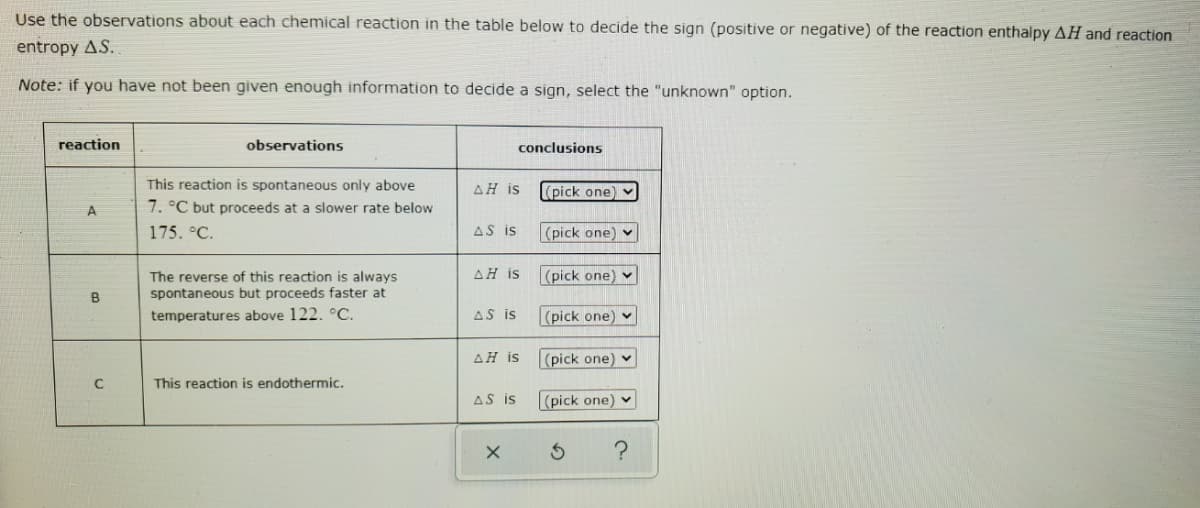Use the observations about each chemical reaction in the table below to decide the sign (positive or negative) of the reaction enthalpy AH and reaction entropy AS.. Note: if you have not been given enough information to decide a sign, select the "unknown" option. reaction observations conclusions This reaction is spontaneous only above 7. °C but proceeds at a slower rate below AH is (pick one) A 175. °C. AS is (pick one) AH is (pick one) The reverse of this reaction is always spontaneous but proceeds faster at B temperatures above 122. °C. AS is (pick one) v AH is |(pick one) v This reaction is endothermic. AS is (pick one)
Use the observations about each chemical reaction in the table below to decide the sign (positive or negative) of the reaction enthalpy AH and reaction entropy AS.. Note: if you have not been given enough information to decide a sign, select the "unknown" option. reaction observations conclusions This reaction is spontaneous only above 7. °C but proceeds at a slower rate below AH is (pick one) A 175. °C. AS is (pick one) AH is (pick one) The reverse of this reaction is always spontaneous but proceeds faster at B temperatures above 122. °C. AS is (pick one) v AH is |(pick one) v This reaction is endothermic. AS is (pick one)
Chemistry: An Atoms First Approach
2nd Edition
ISBN:9781305079243
Author:Steven S. Zumdahl, Susan A. Zumdahl
Publisher:Steven S. Zumdahl, Susan A. Zumdahl
Chapter16: Spontaneity, Entropy, And Free Energy
Section: Chapter Questions
Problem 2RQ: What is the second law of thermodynamics? For any process, there are four possible sign combinations...
Related questions
Question
help please k.

Transcribed Image Text:Use the observations about each chemical reaction in the table below to decide the sign (positive or negative) of the reaction enthalpy AH and reaction
entropy AS.
Note: if you have not been given enough information to decide a sign, select the "unknown" option.
reaction
observations
conclusions
This reaction is spontaneous only above
ΔΗ is
(pick one) v
A
7. °C but proceeds at a slower rate below
175. °C.
AS is
(pick one)
The reverse of this reaction is always
AH is
(pick one) v
B
spontaneous but proceeds faster at
temperatures above 122. °C.
AS is
(pick one)
AH İS
|(pick one) v
This reaction is endothermic.
AS is
|(pick one)
Expert Solution
This question has been solved!
Explore an expertly crafted, step-by-step solution for a thorough understanding of key concepts.
Step by step
Solved in 4 steps with 4 images

Knowledge Booster
Learn more about
Need a deep-dive on the concept behind this application? Look no further. Learn more about this topic, chemistry and related others by exploring similar questions and additional content below.Recommended textbooks for you

Chemistry: An Atoms First Approach
Chemistry
ISBN:
9781305079243
Author:
Steven S. Zumdahl, Susan A. Zumdahl
Publisher:
Cengage Learning

Chemistry
Chemistry
ISBN:
9781305957404
Author:
Steven S. Zumdahl, Susan A. Zumdahl, Donald J. DeCoste
Publisher:
Cengage Learning


Chemistry: An Atoms First Approach
Chemistry
ISBN:
9781305079243
Author:
Steven S. Zumdahl, Susan A. Zumdahl
Publisher:
Cengage Learning

Chemistry
Chemistry
ISBN:
9781305957404
Author:
Steven S. Zumdahl, Susan A. Zumdahl, Donald J. DeCoste
Publisher:
Cengage Learning


Chemistry for Engineering Students
Chemistry
ISBN:
9781337398909
Author:
Lawrence S. Brown, Tom Holme
Publisher:
Cengage Learning

Chemistry: The Molecular Science
Chemistry
ISBN:
9781285199047
Author:
John W. Moore, Conrad L. Stanitski
Publisher:
Cengage Learning

Principles of Modern Chemistry
Chemistry
ISBN:
9781305079113
Author:
David W. Oxtoby, H. Pat Gillis, Laurie J. Butler
Publisher:
Cengage Learning